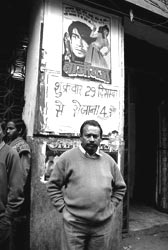|
|
|||||||||||||||||||||
SARAI: THE NEW MEDIA INITIATIVE
Sarai Collective
Delhi - The Context of SaraiThe streets of Delhi are now dug up to lay fibre optic cables, and tracks for a long awaited metro. Frequent power cuts, evictions, demolitions, and the everyday violence of a harsh and unequal city speak of a different order of reality. We live in desperate times, in Delhi. And it is the very nature of our times that make communication, and reflection crucial to survival in Delhi. A city of close to 14 million, one of the fastest growing urban spaces in the planet, is searching for ways to connect to itself and to the world. Sarai: the New Media Initiative, a programme of the Centre for the Study of Developing Societies is a part of this process of looking for ways to communicate and reflect the contemporary urban condition in our part of the world. Sarai tries to address some of the questions of communication and reflection that are vital to our everyday lives in Delhi.
To understand the need for this, it may be necessary for us to take a brief step back to the summer of 1998, when five of us, (Ravi Vasudevan & Ravi Sundaram from CSDS, and Jeebesh Bagchi, Monica Narula & Shuddhabrata Sengupta from the Raqs Media Collective began to conceive of Sarai). The summer of '98 was a time for many new beginnings in the city of Delhi. The nineties had been a decade marked by doubt and rethinking on many fronts, all of which seemed to have come to a head for some of us during that summer. There was a sense of disquiet with increasing urban violence and strife, dissatisfaction with restrictive modes of thinking and practice within mainstream academia, the universities & the media and a general unease at the stagnation that underlay the absence of a critical public culture.
 |
At the same time, Delhi witnessed a quiet rebirth of an independent arts and media scene. This became evident in exhibitions and screenings that began taking place modestly in alternative venues, outside galleries and institutional spaces, and in archival initiatives that began to be active. Spaces for dissent and debate were being kept alive by clusters of teachers and students in the universities. New ideas, modes of communication and forms of protest were being tried out and tested on the streets. There was a vibrant energy evident in street level improvisations with new technologies. Public phone booths were transforming themselves into street corner cyber cafés, independent filmmakers were beginning to organise themselves in forums and a new open source and free software community made its mark in the city's BBSs (Electronic Bulletin Boards). The city itself, as a space and as an idea, was becoming a focus for inquiry and reflection, and a provocation for a series of creative experiments. |
How Sarai Happenned
It was from within this ferment of ideas, rough & ready plans, and fragments of proposals, that a series of conversations on film history, new media theory, media practice and urban culture was able to mature into the conceptual foundation of Sarai. Sarai (the space and the programme) takes its name from the caravan-serais for which medireview Delhi was well known. These were places where travelers and caravans could find shelter, sustenance and companionship; they were taverns, public houses, meeting places; destinations and points of departure; places to rest in the middle of a journey. Even today, the map of Delhi carries on it twelve place names that include the word Sarai. The Sarai Initiative interprets this sense of the word "sarai" to mean a very public space, where different intellectual, creative and activist energies can intersect in an open and dynamic manner so as to give rise to an imaginative reconstitution of urban public culture, new/old media practice, research and critical cultural intervention.
The challenge before the founding group was to cohere a philosophy that would marry this range of concerns to the vision of creating a lively public space where research, media practice and activism could flow into each other. It took two years (1998-2000) to translate this conception into a plan for a real space and a design of a workable interdisciplinary programme of activities. Today, the Sarai Initiative embraces interests that include cinema history, urban cultures and politics, new media theory, computers, the Internet and software cultures, documentary filmmaking, digital arts and critical cultural practice. Sarai opened its doors to the public of Delhi in February 2001 and the first year has been very hectic for all of us, especially as all our projects and public interventions have begun to take concrete shape As we draw towards the completion of our first year we realize that our strength lies in the collaborative vision that has been the founding principle of Sarai and that the space can grow only by continuing to include and engage with new people and ideas. From across the world.
The Centre for the Study of Developing Societies
Sarai is a programme of the Centre for the Study of Developing Societies, Delhi (CSDS). The CSDS founded in 1964, is one of India's best-known independent research institutes. Bringing together some of South Asia's best known thinkers and writers, the CSDS has played an important part in shaping the intellectual and creative map of this part of the world. The CSDS' research has focused on democratic politics, cultures and the politics of knowledge, critical discourses on science and technology, and violence, ethnicity and diversity. Added to this has been an important new programme of the Centre: Sarai, which reflects the Centre's very contemporary concerns in intellectually and creatively addressing issues of the new millennium. Sarai Projects and Spaces
Today, Sarai includes under its ambit, a media lab which is a focus of creative and experimental work in various media (video, audio, print, internet), a programme for the development of Hindi language resources in cyberspace , a free software development programme, a public access space (the Interface Zone) which is a platform for the exhibition of new media projects - and an active Outreach Programme (The Cyber Mohalla Project - or - Cyber Neighbourhood Project) which works in a slum in central Delhi to create resources of digital creativity for young people in disadvantaged spaces.
Additionally, two inter-disciplinary research & practice projects - Mapping the City, and Publics & Practices in the History of the Present act as catalysts for a variety of intellectual and creative interventions at Sarai Sarai has embarked on a publication programme, and the first Sarai Reader on the theme of the Public Domain was published in February 2001. The Sarai Reader aims to be an annual publication and will bring together each year a range of new critical writing around themes that connect cities, communication, public cultures, new media, media history and and information politics. The Sarai Reader 01 a joint publication of Sarai, CSDS, Delhi and the Society for Old and New Media, Amsterdam, edited by the Raqs Media Collective (Sarai) and Geert Lovink is available online at www.sarai.net/journal/reader1.html
Research
 |
Sarai places a great deal of emphasis on developing new and critical interdisciplinary theoretical work. The research agenda of Sarai is organised towards two complementary themes - understanding the place of the media in urban public practice and consciousness, and reflections on the city as constituted through representations and technologies. The research on media is directed towards understanding the rhythms and routines of daily life in the city as mediated through words, images and sounds. Our particular concern is with the possibilities involved in people's relationship to the media, the domain of 'needs', 'desires' work and leisure, creativity and communication practices that the media world opens up. The analysis of urban life attends to the varied dimensions of everyday life. These range from planning and housing to geographies of the city, mediated through work, leisure, transport and communication. Technological forms that underwrite contemporary urban experience as well as the social practices through which the city is imagined and acted upon will be addressed in our research. |
People
Sarai has a core team of eighteen people from different backgrounds and disciplines (filmmakers, academics, software programmers, lawyers, social workers, activists, designers, writers, researchers and media producers) who work on a regular basis on different collaborative and individual projects. Apart from this, there are eighteen seed grants and fellowships that have been given out this year for different research and media projects on themes that resonate with Sarai's interests with city spaces, urban cultures and media forms. Sarai has also embarked on a modest residency programme for visiting artists, practitioners and scholars to work and interact with Sarai fellows.
Sarai and the Public : The Interface Zone
The Sarai website and the digital interface located in the Interface Zone at Sarai render all of Sarai's work public - this includes, an emerging archive of urban culture, an online gallery of new media works and an active discussion list - the Reader-List which began in February 2001 and has more than two hundred subscribers at present. The Reader List is archived online. Sarai is becoming recognised as an important alternative venue in Delhi for discussions, workshops on the politics of media culture and urban space, screenings and as a convivial space where many young people can feel comfortable in an increasingly constricted cultural milieu. In laying open the possibilities of a new communicative ethic, and a space for connectivity between different strands of intellectual work, cultural intervention, technological innovation and a commitment to free speech and open culture Sarai hopes to create a modest autonomous space for public creativity in Delhi.